
Governor's foreword
The end of 2021 felt much like the beginning—full of cautious optimism but clouded by near-term uncertainty about the path of the COVID‑19 pandemic and its impact on the economy. But in fact much has changed.
During the year, shutdowns and public health restrictions gave way to vaccinations and a large-scale reopening of businesses. As a result, the economy grew vigorously during the second half of 2021. And as the recovery gained strength, we adjusted our monetary policy support—reducing and eventually ending quantitative easing in October.
But restarting the global economy also brought new challenges. The unique circumstances of the pandemic spurred a global surge in the demand for goods and disrupted global supply chains. Shutdowns and ongoing public health protocols in many countries hindered production and transportation, leading to sharply higher prices for many goods in Canada and around the world. Largely as a result, inflation in many countries increased substantially. In Canada, consumer price index inflation rose well above the Bank’s 1% to 3% control range, reaching 4.8% in December. That has made it harder for Canadians to make ends meet—particularly those with low incomes.
In 2021, the Bank and the Government of Canada renewed our agreement on Canada’s monetary policy framework. The agreement reaffirms that price stability is the primary objective of monetary policy.”
Tiff Macklem, Governor
In 2021, the Bank of Canada and the Government of Canada renewed our agreement on Canada’s monetary policy framework. The agreement reaffirms that price stability is the primary objective of monetary policy with a 2% inflation target. The renewed agreement provides continuity and clarity and strengthens our framework to manage the realities of the world we live in. This is the framework Canada needs now as we confront elevated inflation and the challenges of reopening the economy. And, looking beyond the pandemic, it is what we need for the future.
Throughout 2021, we sought to better understand the complexities of the economic recovery. We used innovative tools and approaches to help us assess the impact of global supply disruptions, better understand the drivers of elevated inflation and better interpret labour market developments. We exchanged information and insights with our global counterparts. All of this work played a vital role in informing and guiding our monetary policy decisions.
We also kept a close eye on Canada’s housing market. We worked to understand how shifting housing preferences and continued strong demand contributed to financial vulnerabilities as some households stretched their budgets to buy houses, taking on elevated levels of debt relative to their incomes. This work included analysis of extrapolative expectations in major housing markets across Canada as well as the growing impact of investors on housing demand.
Amid all the uncertainty, we maintained our commitment to transparency and promoted public understanding and trust through effective communications and engagement.
Of course, our work went beyond the challenges of the pandemic.
We continued to improve our understanding of the economic and financial system risks associated with climate change. Working with the Network for Greening the Financial System, we developed strategies to mitigate transition risks and promote sustainable finance. In partnership with the Office of the Superintendent of Financial Institutions and the financial services industry, we developed and conducted scenario analysis to assess how the economy and financial system may be affected by the transition to a lower-carbon economy. We also launched a new greening strategy for the Bank itself, with concrete targets to reduce greenhouse gas emissions across the Bank’s operations.
We continued our focus on both our operational resilience and the resilience of the financial system, including a new cyber security strategy focused on response and recovery capabilities.
Through research and outreach, we advanced our understanding of Canadians’ evolving use of cash and preferred payment methods. We also continued the modernization of our bank note processing centres and contributed to the launch of Canada’s new large-value payment system, Lynx. And, looking to the future, we accelerated our work exploring the benefits and design of a central bank digital currency.
In 2021, the Bank added a fifth core function, with a new mandate for retail payments supervision in Canada. We began to lay the foundation for our new risk monitoring and enforcement activities and started work on our approach to register payment service providers.
In addition to performing the core functions that Canadians count on us for, we evolved and affirmed the values that underpin the work we do—to think ahead, include everyone and inspire confidence. And we set the stage for the years ahead with the launch of our 2022–24 strategic plan, Delivering on Our Promise. This strategic plan responds to our rapidly evolving environment, while allowing our goals to remain ambitious. It is the roadmap for an organization that is truly dynamic, engaged and trusted—no matter what challenges we face.
No matter what 2022 brings, we will continue to promote the economic and financial well-being of Canadians from coast to coast to coast.”
Tiff Macklem, Governor
We implemented a robust strategy to support equity, diversity and inclusion. This included new targets for improved diversity at the Bank and scholarships for racialized students. We also had collaborative discussions with G7 central banks on how to accelerate progress on diversity and inclusion in our institutions and in economics and finance more broadly. And we strengthened our engagement with Indigenous Peoples, co-founding the Central Bank Network for Indigenous Inclusion and co-hosting the first Symposium on Indigenous Economies.
Finally, COVID‑19 prompted us to look at how we work during a pandemic and beyond. We have made significant progress in making sure our physical and online spaces—as well as our employees—are ready for a new hybrid work model.
The year 2021 ended on a high note. First, in December, we welcomed the Bank’s new Senior Deputy Governor, Carolyn Rogers. She joins a formidable team of dedicated public servants who have consistently demonstrated their integrity and professionalism, despite the personal challenges the year brought. And, second, we were named as one of Canada’s Top 100 Employers for the 12th consecutive year and one of Canada’s Best Diversity Employers.
On behalf of the Bank’s Board of Directors and staff, I pledge the Bank’s continued service to Canadians as we face new challenges in the year ahead. No matter what 2022 brings, we will continue to promote the economic and financial well-being of Canadians from coast to coast to coast.
Canadians can count on us.
Tiff Macklem
Governor

2021 by the numbers
4.5%
Canada’s real gross domestic product growth as estimated at December 31, 2021
3.4%
Consumer price index inflation
0.25%
Policy interest rate at year-end
78.88
US cents—Exchange rate for Can$1 as at December 31, 2021
$281.4
billion—Nominal value of marketable bonds issued in 2021
$134.8
billion—Nominal value of Government of Canada bonds purchased under its Government of Canada Bond Purchase Program
2,050
Number of Bank of Canada employees
$293.6
thousand—Total staff donations to the Bank of Canada workplace charitable campaign

Mandate and planning framework
Mandate
The Bank of Canada is the nation’s central bank. Its mandate, as defined in the Bank of Canada Act, is “to promote the economic and financial welfare of Canada.” Its vision is to be a leading central bank—dynamic, engaged and trusted—committed to a better Canada.
The Bank has five core functions:
- Monetary policy—to keep inflation low, stable and predictable
- Financial system—to promote safe, sound and efficient financial systems within Canada and internationally
- Currency—to design, issue and distribute Canada’s bank notes
- Funds management—to act as fiscal agent for the Government of Canada, advising on and implementing its public debt and foreign exchange reserve strategies
- Retail payments supervision—to supervise payment service providers in order to build confidence in the safety and reliability of their services and to protect users from specific risks1
Efficient, cost-effective and innovative operations help the Bank achieve its mandate and business objectives.
Planning framework
A robust planning framework puts the Bank’s vision and mandate into practice. Every three years, the Bank develops a strategic plan to establish its goals, priorities and measures of success.
The strategic plan:
- helps the Bank anticipate and adapt to the realities of its operating environment
- guides annual planning and budgeting activities
- serves as the foundation for departmental and employee performance agreements
In 2021, the Bank concluded its 2019–21 medium-term plan, Leading in the New Era. This plan was built on a foundation of three themes and helped bring to life the Bank’s vision.
In September, the Bank launched its 2022–24 strategic plan, Delivering on Our Promise. This strategic plan takes a higher-level approach than previous plans. Its five overarching themes provide a framework to guide decision making while leaving room for the flexibility and agility needed in a changing environment.
Reporting
The Bank is committed to:
- publishing information about how it works
- reporting on its financial and non-financial performance during the year
- 1. Retail payments supervision became a new core function in 2021.[←]
On this page
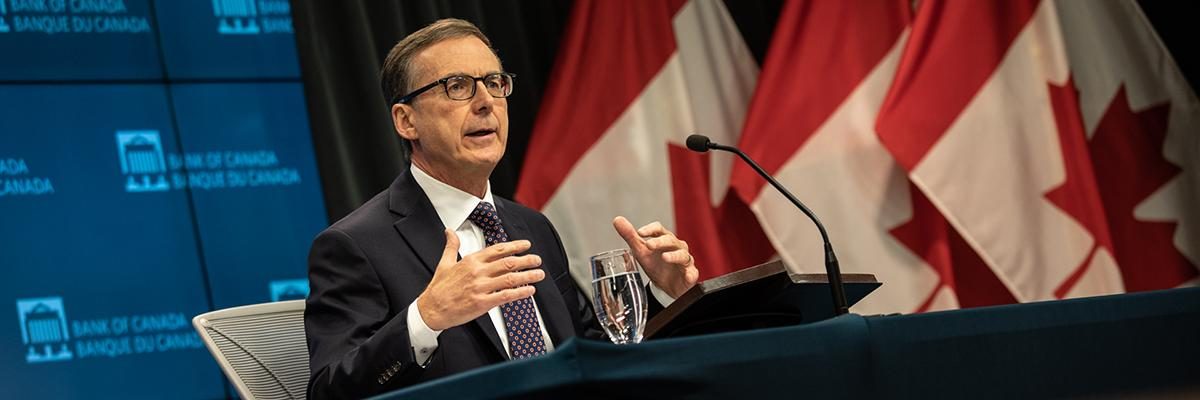
Monetary policy
The Canadian economy continued to recover from the effects of the COVID‑19 pandemic in 2021. As vaccination rates increased and health restrictions eased, growth—including in hard-to-distance services sectors—became more widespread.
The labour market also made impressive gains, and the very uneven impacts of the pandemic on the employment of women and youth were largely reversed. By the end of the year, employment had returned to its pre-pandemic level.
While the recovery was strong in 2021, reopening the economy brought new challenges. Disruptions to global supply chains pushed up the prices of many goods. Combined with higher energy and food prices, this contributed to rising inflation in Canada and in other countries. These supply disruptions also restrained economic activity.
Uncertainty remained heightened at the end of 2021. The spread of new variants of the virus continued to prolong the pandemic. The outlook for gross domestic product (GDP) and potential output remained difficult to assess due to:
- supply disruptions
- ongoing structural changes, such as digitalization
Supporting the pandemic recovery
The Bank took several important steps in 2021 to support the pandemic recovery.
Tracking economic conditions in the second year of the pandemic
Global economic activity continued to improve through 2021, but progress remained choppy and uneven. By the end of the year, the recovery had a firmer foundation in advanced economies than it did in emerging-market economies, mainly because of higher vaccination rates and more stimulative policy measures.
Strong demand for goods—which bolstered global manufacturing and trade—supported global growth. However, transportation bottlenecks and shortages of semiconductors and construction materials limited production in some sectors that are important for Canadian exports, such as motor vehicles and parts and construction.
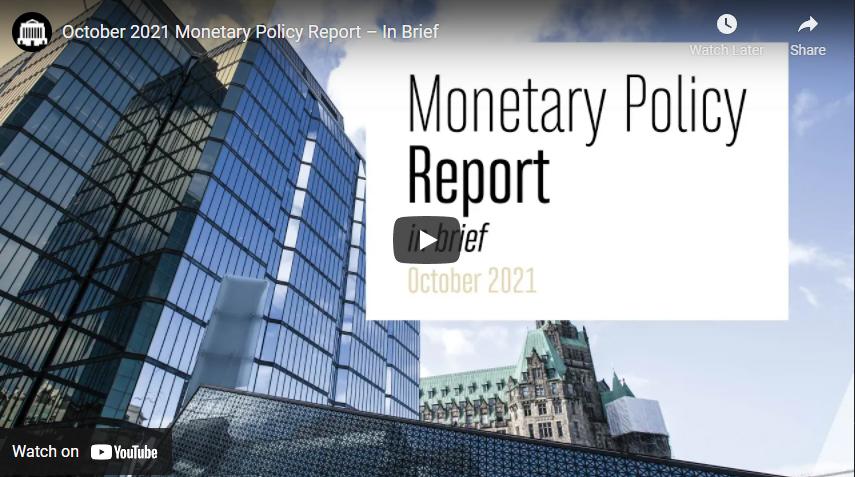
https://www.youtube.com/watch?v=fyrwPdkWQbs
The rebound of the Canadian economy that began in the second half of 2020 continued into 2021. Progress stalled, however, in the second quarter of 2021 with the reintroduction of measures to contain the spread of the virus coupled with supply chain issues and a slowing in the housing market.
As the virus receded and vaccination rates rose rapidly, public health restrictions were eased and growth was robust through the second half of the year.
The Canadian labour market recovered strongly, and by the end of the year:
- the unemployment rate was approaching where it had been before the pandemic
- employment returned to its pre-pandemic level
Against this backdrop, businesses reported increased challenges filling vacant jobs, especially for skilled trades and digital workers. In many hard-hit service industries, employers also struggled to find workers quickly enough to meet the surge in demand as the economy reopened.
WATCH: In a virtual speech before @SBofT, Deputy Governor Toni Gravelle discusses supply shortages and the current rate of inflation and shares insight on yesterday’s monetary policy decision. #cdnecon December 9, 2021

https://twitter.com/bankofcanada/status/1469004447686742026
Understanding the factors pushing inflation above target
Consumer price index inflation (CPI) rose above the Bank’s target range. Four key factors contributed to rising prices:
- base-year effects2
- increased prices for goods, including food, as a result of global and domestic supply disruptions coupled with high demand
- stronger energy prices
- a rebound in demand in hard-to-distance sectors as pandemic restrictions were eased
In response to the rise in inflation, near-term inflation expectations picked up, but long-term inflation expectations remained well anchored. This anchoring is critical to monetary policy because the economic decisions people and businesses make today are influenced by their expectations for how prices are likely to evolve in the future. These decisions in turn feed into the actual rate of price increases.
| Achievement of target for consumer price index (CPI) inflation | ||||||
| Key indicators | Reference level | 2017 | 2018 | 2019 | 2020 | 2021 |
| CPI inflation (%) | 2.0 | 1.6 | 2.3 | 1.9 | 0.7 | 3.4 |
| Average CPI inflation since 2001 (%) | 1.9 | |||||
| Inflation expectations at a 10-year horizon (%) | 2.0 | 2.0 | 2.0 | 2.0 | 2.0 | 2.0 |
Providing stimulus through monetary policy
Overall, the economy required considerable monetary policy support in 2021. The Bank therefore held the policy interest rate at the effective lower bound—0.25%—and remained committed to keeping it there until economic slack is absorbed so that the 2% inflation target is sustainably achieved.
Through the year, the Bank adjusted its quantitative easing (QE) program. It reduced the amount of net new purchases of Government of Canada bonds in April and again in July, before ending QE in late October. The Bank then entered a reinvestment phase and signalled that it would continue purchasing government bonds to replace maturing ones to keep its overall holdings roughly constant. The Bank will continue this reinvestment phase at least until the policy rate begins to rise.
We remain committed to holding the policy interest rate at the effective lower bound until economic slack is absorbed so that the 2 percent inflation target is sustainably achieved. Find out more. #economy #cdnecon http://ow.ly/87FN50H6k6W December 8, 2021

https://twitter.com/bankofcanada/status/1468626522651213826
Supporting the Bank’s monetary policy function
Timely and thorough analysis supported monetary policy decisions throughout the year. Bank staff continued to assess the pandemic’s impact on the global and Canadian economies.
Despite the highly complex forces affecting total supply and demand, the Bank correctly anticipated that GDP growth would slow in the first half of 2021 before picking up in the second half of the year. However, the rise in inflation in the second half was greater than expected.
Staff leveraged insights from new data sources and adjusted the questions in Bank surveys to better inform economic projections and policy decisions.3 Still, the uncertainty surrounding both global and domestic economic forecasts remained unusually high. This was largely due to the pandemic’s unpredictability and the unprecedented nature of the associated economic shock. While some of the disruptions were expected, others—particularly the extent and duration of supply disruptions—were significantly more pronounced than had been anticipated.
Bank staff developed a comprehensive framework to assess labour market slack; this tool applies directly to the ongoing economic recovery from the pandemic.4 The framework uses a detailed approach that can identify important areas of weakness and strength in the labour market.
ICYMI: Deputy Governor Lawrence Schembri explains why we are developing new tools to measure the health of the labour market. #cdnecon http://ow.ly/NGoJ50GPV6SNovember 17, 2021

https://twitter.com/bankofcanada/status/1461016385363001347
Staff also used high-frequency, transaction-level data to better understand consumers’ payment habits during the pandemic.5 Such data helped the Bank accurately forecast the strength of the rebound in the second half of the year.
In addition, staff completed analysis of macroeconomic climate transition scenarios as part of the Bank’s pilot project with Canadian financial institutions. The Bank is among the first central banks to combine climate-economy models with macroeconomic models to assess transition risks.
Renewing the Bank’s monetary policy framework
Following a comprehensive review and consultation process, the Bank renewed its monetary policy agreement with the federal government in 2021.
Looking forward
In 2022, the Bank will focus on monitoring the recovery in supply and demand and on understanding the medium- to long-term economic consequences of the pandemic. In addition, the Bank will:
- continue to improve current macroeconomic models, including through a richer characterization of labour markets and more realistic specifications for expectations.
- extend new forecasting tools using non-traditional data sources.
- improve surveys and outreach to better understand the changing economy. In particular, the Bank will undertake a new online business survey and work on enhancing its understanding of the Indigenous economy by examining characteristics of and conditions within the Indigenous business sector.
- continue to explore the effects of digitalization, automation and adoption of advanced technologies and their implications for the Canadian economy, with a particular focus on labour markets and productivity.
- assess the impact of both physical risks associated with climate change and risks from a climate-related transition to a low-carbon economy.
- 2. CPI inflation is measured by comparing the price of the CPI basket today with its price (or “base”) a year ago. This means that a large movement in the prices of items in the basket causes volatility: inflation moves in one direction at first and then reverses direction a year later. This reversal is known as the base-year effect. For more information, see the Bank’s explainer on the consumer price index.[←]
- 3. For example, a new database from Indeed provided information on how online job postings linked to digital technologies evolved during the pandemic (reported in the Bank’s July Monetary Policy Report). New features were also added to the Canadian Survey of Consumer Expectations, including follow-up interviews to better understand inflation expectations and the health of the labour market. In addition, staff developed a new online business survey (the Business Leaders’ Pulse) that reaches a broad set of businesses to provide timely information on business conditions and expectations.[←]
- 4. E. Ens, L. Savoie-Chabot, K. See and S. L. Wee, “Assessing Labour Market Slack for Monetary Policy,” Bank of Canada Staff Discussion Paper No. 2021‑15 (October 2021).[←]
- 5. T. Dahlhaus and A. Welte, “Payment Habits During COVID‑19: Evidence from High-Frequency Transaction Data,” Bank of Canada Staff Working Paper No. 2021‑43 (September 2021).[←]
On this page

Renewing the Bank’s monetary policy framework
Every five years, the Bank and the Government of Canada review and renew their agreement on Canada’s monetary policy framework. In 2021, Canada’s flexible inflation-targeting framework was renewed for 2022 to 2026.
The framework’s foundation remains a 2% inflation target within a control range of 1% to 3%. The agreement reaffirms price stability as the Bank’s primary objective and lays out how the Bank will continue to use the flexibility built into its framework to address challenges confronting our economy.
This includes using the Bank’s extended monetary policy tools when needed and actively seeking the level of maximum sustainable employment that is consistent with price stability, when conditions warrant. The agreement recognizes that the Bank is considering a broader range of labour market indicators to assess full employment and the economy’s potential output.
Consulting with Canadians
As part of the renewal process, the Bank held open consultations with the Canadian public and discussions with a broad set of stakeholders, experts and interest groups. This comprehensive exercise ensured that diverse views were considered.
The Bank sought input on the monetary policy framework and learned how inflation affects different socio-economic groups. More than 8,500 Canadians from across the country participated in an online survey, while many others participated in focus groups, round-table discussions and other consultations.
The Bank concluded its public outreach activities in 2021 and published a report summarizing what it learned. The report was an important input to the renewal.
Researching alternative monetary policy frameworks
Leading up to the renewal, staff conducted critical research. Using a combination of model simulations, lab experiments and public consultations, staff ran a “horse race” to weigh the pros and cons of the main alternatives to flexible inflation targeting:
- average inflation targeting
- dual mandate
- nominal gross domestic product (NGDP)–level targeting
- NGDP-growth targeting
- price-level targeting
This was the first such comparison since the Bank adopted inflation targeting in 1991.
Staff assessed the robustness of each option at the effective lower bound using a suite of models that reflect a range of assumptions about household diversity and private sector expectations.6
The current flexible inflation-targeting framework, average inflation targeting and a dual mandate did better than other approaches that represent larger departures from the status quo. While neither average inflation targeting nor a dual mandate was judged to be an overall improvement over the current approach, the Bank found value in some elements of each of these alternatives.
Further to this research, however, the Bank concluded that the inflation-targeting framework is flexible enough to incorporate these key elements while avoiding the drawbacks associated with the alternative approaches.
Read the joint statement from the Bank of Canada and the Government of Canada on the renewal of the Bank’s inflation-control mandate until Dec. 31, 2026. #cdnecon https://t.co/64D0Tzo1fz
— Bank of Canada (@bankofcanada) December 13, 2021

https://twitter.com/bankofcanada/status/1470409769739563009
More information
- 6. Staff used a model with a variety of households to assess the distributional effects of alternative frameworks. Robustness analyses with models using alternative expectations are important because private sector expectations play a crucial role in the economic performance of monetary policy frameworks.[←]
On this page

Funds management
The Bank’s funds management activities in 2021 largely continued at the same heightened pandemic-related levels as in 2020. The Government of Canada continued financing its COVID‑19 support measures, issuing still-elevated amounts of federal government debt into the market.
In 2021, the Bank maintained its operations across multiple sites to ensure resilience during the pandemic.
As outlined in the federal government’s 2021–22 debt management strategy, long-term debt issuance increased further and remained a significant portion of total Government of Canada debt issuance. The Canadian financial market proved resilient and was able to absorb the ongoing elevated issuance without any disruption to market functioning.
Sources: Department of Finance Canada, Statistics Canada and Bank of Canada
Wondering how the Bank’s balance sheet works? Let us help you make sense of the numbers. #cdnecon #economy https://t.co/tFlYI2ICI6
— Bank of Canada (@bankofcanada) September 10, 2021

https://twitter.com/bankofcanada/status/1436389417447526400
Providing funds management policy advice
Given shifts in the timing of adjustments to pandemic-related government support programs and the larger-than-expected rise in tax revenue, there was a higher degree of uncertainty in funding requirements. This made for a year of challenging work for the Bank as a fiscal agent.
The Bank advised the Government of Canada on funds management and remained involved in daily funds management activities. These included continuing to conduct more frequent and larger debt auctions than those held before the pandemic. The Bank continued to support the government’s ability to raise a significant amount of funds in a flexible manner. It also provided strategic advice on the government’s plans to issue its first green bond.
To further strengthen its strategic advice on managing the federal government’s debt, the Bank enhanced some of its financial modelling tools. These improvements will better support the objectives of the federal government’s debt management strategy, particularly as the government seeks to substantially increase its longer-term debt issuance to finance the additional fiscal requirements associated with the COVID‑19 pandemic. More generally, the strategy aims to raise stable and low-cost funding to meet the government’s financial requirements while maintaining a well-functioning market for Government of Canada securities.
Continuing to improve systems and automate processes
To reinforce its funds management function, the Bank further improved the systems it uses to conduct and support its fiscal agent role. This included enhancing and further automating several of its auctions and operations while managing Canada’s public debt programs. For both the Bank and financial market participants, these enhancements:
- modernized information technology processes
- increased operational scalability and flexibility
- reduced operational risk
From a systems perspective, auctions of Government of Canada securities (bonds, treasury bills and ultralong bonds) as well as other operations used to manage the government’s debt are all more efficient now.
The Bank made additional improvements to its systems and processes to reduce risk and further increase the efficiency and resilience of its banking operations. Specifically, the Bank:
- significantly mitigated its exposure to risk of financial crimes by successfully implementing manual and automated controls for unusual and high-risk payment activity
- implemented artificial intelligence and robotic process automation to:
- make its back-office operations more scalable
- eliminate low-value work
- improve compliance and accuracy
Adapting to changing financial markets
As part of the worldwide effort to ensure that interest rate benchmarks are robust, global authorities are working with the private sector to transition from the London Interbank Offered Rate (LIBOR) to risk-free rates. The Bank enhanced its internal systems and reporting and tested these improvements with counterparties. It has now achieved operational readiness in its transition from LIBOR to the risk-free Secured Overnight Financing Rate (SOFR).
These efforts enabled the Bank to:
- reduce the Government of Canada’s current LIBOR exposure
- begin funding the government’s international foreign reserves with financial instruments referencing SOFR
Phasing out Canada Savings Bonds and repatriating operations
The Bank continued taking important steps to update its operations in response to the Government of Canada’s 2017 decision to discontinue Canada’s Retail Debt Program. All remaining outstanding retail bonds matured in 2021. The total outstanding retail debt declined from $4.996 billion in 2017 to $591 million as at the end of 2021.
The Bank is on track in its efforts to shift the operations of the Retail Debt Program in-house.
Looking forward
In 2022, the Bank will:
- launch a competitive process to select a service provider to partner with the Bank to design, implement and support the next generation of its high-availability core banking platform
- draw on lessons learned from the experience of the COVID‑19 pandemic to inform the advice it provides to the Government of Canada on strategic debt and liquidity management
- implement a new technology solution that supports both unclaimed bank balances and retail debt products
More information
Government of Canada Announces Structuring Advisors to Assist with Inaugural Issuance of Green Bonds
On this page

Financial system
The COVID‑19 pandemic caused a massive disruption to the Canadian economy. But the financial system proved to be resilient and acted as a shock absorber for the broader economy. Canadian banks were well capitalized going into the pandemic.
In addition, governments and the Bank provided unprecedented policy support. Consequently, commercial banks were able to continue lending to households and businesses throughout the economic downturn.
At the start of the crisis, the Bank took extraordinary measures to provide liquidity to:
- resolve the initial stress
- ensure that critical markets and the financial system continued to function well
Because these measures were successful, the Bank discontinued most of its emergency support programs by spring 2021.7
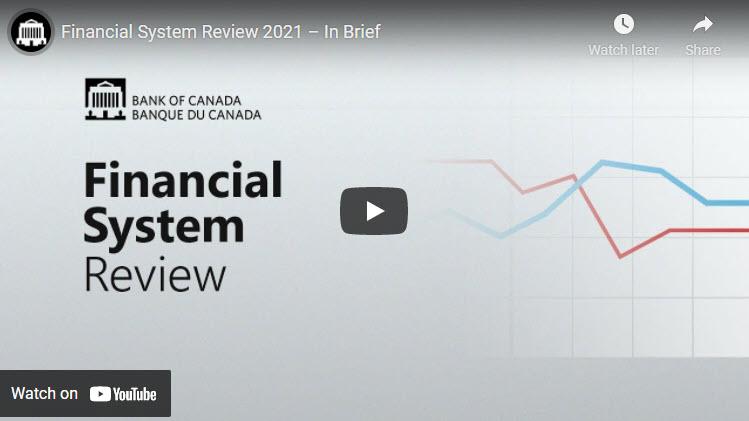
https://www.youtube.com/watch?v=cZb8lKfY7AM
Vulnerabilities and risks
The Bank’s 2021 Financial System Review presented assessments of key vulnerabilities to the financial system. Notably, it highlighted the pandemic’s impact on the financial health of Canadian households and businesses as well as some other issues of potential concern.
Throughout the year, Bank staff worked to understand vulnerabilities related to household debt and the housing market. In particular, staff used microdata to investigate the characteristics of new mortgages that are most often associated with household financial stress.8
Staff also developed innovative indicators to better understand the role that expectations and investor demand played in boosting activity and prices in the housing market during the pandemic.9 In addition, new research identified important differences in the response of housing supply to higher prices at the local level.10
In other research, Bank staff documented trends in Canada’s financial landscape, such as the rapid growth of non-bank financial intermediation.11 This development has made the financial system more vulnerable to a spike in demand for liquidity, such as the one that occurred in spring 2020.12
Climate change remained an important area of focus for the Bank in 2021, as it poses important risks to the financial system as well as to individual participants within it.
This research—and much more—was published on the Financial System Hub, the Bank’s main portal for the latest research and analysis on financial stability issues.
Our #Financial System Hub is a one-stop shop for timely work on financial stability. Check out the latest post on Canada’s housing market and household indebtedness. https://t.co/9WI0VUhTnq
— Bank of Canada (@bankofcanada) April 9, 2021

https://twitter.com/bankofcanada/status/1380525564352675840
Financial stability and monetary policy
In 2021, Bank researchers assessed potential imbalances in the housing market and considered their implications for monetary policy. Specifically, by developing and using monetary policy models with linkages to financial stability, staff studied how changes in house prices affect the overall economy.13
Further, as a continuation of 2020 work undertaken in the Bank’s Heterogeneity Laboratory (HetLab),14 staff simulated how vulnerabilities linked to household debt evolved during the pandemic for different groups and overall.15
Promoting financial system resilience
The financial system is the Canadian economy’s foundation, and the Bank works in a variety of ways to promote its efficiency and resilience.
Domestic partnerships
The Bank regularly collaborates with federal and provincial authorities to monitor and assess stress on individual commercial banks and the system as a whole.
In 2021, the Bank shared its analysis and research on the vulnerabilities stemming from housing market imbalances and elevated household indebtedness with members of the Senior Advisory Committee and the Heads of Regulatory Agencies. Subsequently, the Office of the Superintendent of Financial Institutions and the Department of Finance Canada announced the tightening of mortgage requirements.16
The Bank also:
- used insights gathered through the Systemic Risk Surveillance Committee (with both provincial and federal members) to help identify and assess vulnerabilities in the financial system17
- conducted a tabletop exercise with its partners in the Canadian Financial Sector Resiliency Group to simulate a cyber incident
The Bank and its industry partners made significant progress on developing a framework to support smooth trading and settlement of Government of Canada securities in a low interest rate environment. The proposed framework includes best practices to facilitate timely settlement, as well as a financial penalty for failing to deliver securities.
The Bank also continued to partner with Payments Canada and industry organizations to modernize Canada’s core payment systems. In August, Canada’s new large-value payment system, Lynx, was launched successfully. Lynx significantly improves the resilience of this essential component of Canada’s financial infrastructure.
Bank staff produced extensive research that helped inform this work. This included assessing:
- the factors that influence consumers’ payment choices
- how these choices could affect payment volumes in different systems18
When Lynx was launched, the Governor designated it as a systemically important payment system, moving it under the Bank’s oversight.19
“The launch of Lynx is an important step in making sure Canada’s financial system remains secure, stable and efficient in today’s rapidly evolving economy.” -BoC Governor Tiff Macklem#cdnecon #economy #payments https://t.co/cpx7qTAOLj
— Bank of Canada (@bankofcanada) September 1, 2021

https://twitter.com/bankofcanada/status/1433128277431013379
Oversight of payments and financial market infrastructures
In 2021, the Bank reached important milestones in several multi-year initiatives to strengthen payment systems and financial market infrastructures (FMIs) in Canada.
In October, the Bank released its Expectations for Cyber Resilience of Financial Market Infrastructures report. It also continued ongoing work with FMIs and the broader industry to improve their ability to recover from cyber incidents.
The Bank made significant progress on the implementation of the FMI resolution regime, notably by establishing a coordination framework for federal authorities.
Retail payments supervision
In 2021, the Bank’s tool kit for promoting the resilience of the financial system expanded. Under the Retail Payment Activities Act, the Bank will be responsible for supervising payment service providers.
Interest rate benchmark reform
In the context of ongoing international initiatives, the Bank continued to support the reform of Canadian benchmark interest rates through the Canadian Alternative Reference Rate working group (CARR), which the Bank co-chairs. As the administrator of the Canadian Overnight Repo Rate Average (CORRA), the Bank began publishing a CARR-recommended CORRA Compounded Index in April and introduced a calculator for it in December. This index and calculator are designed to make it easier for market participants to calculate interest and coupon payments for some specific securities.20
During the year, CARR also reviewed and developed recommendations for the Canadian Dollar Offered Rate (CDOR). CARR completed the first stage of its work in December 2021, when it recommended that CDOR’s administrator should cease publication of the rate after June 30, 2024, with no new CDOR exposures after June 30, 2023—except for loans and some derivative hedging activity.21 The discontinuation of CDOR will have significant implications for the Canadian financial system, including for derivatives, floating rate notes and corporate lending. CARR will continue to work with CDOR’s stakeholders to develop the tools and milestones necessary to enable a smooth transition away from CDOR to CORRA, including assessing the need for any alternative benchmarks.
Looking forward
In 2022, the Bank will continue to:
- use microdata to enrich its understanding of financial vulnerabilities and provide timely updates to Canadians of how those vulnerabilities are evolving
- incorporate financial stability considerations into monetary policy, including those arising from household heterogeneity
- work closely with domestic and international partners to share information and promote the resilience of Canada’s financial system
- evolve its oversight of prominent payment systems
- support CARR and industry stakeholders as they work to implement recommendations regarding CDOR
- finalize the framework to support smooth trading and settlement of Government of Canada securities in a low interest rate environment
More information
Regulatory Oversight of Designated Clearing and Settlement Systems
Retail Payments Advisory Committee—Brief Overview of Retail Payments Supervision
- 7. Bank of Canada, “Bank of Canada Announces the Discontinuation of Market Functioning Programs Introduced During COVID‑19” (press release, March 23, 2021).[←]
- 8. O. Bilyk, K. Chow and Y. Xu, “Can the Characteristics of New Mortgages Predict Borrowers’ Financial Stress? Insights from the 2014 Oil Price Decline,” Bank of Canada Staff Analytical Note No. 2021-22 (September 2021).[←]
- 9. U. Emenogu, C. Hommes and M. Khan, “Detecting Exuberance in House Prices Across Canadian Cities,” Bank of Canada Staff Analytical Note No. 2021-9 (May 2021).[←]
- 10. N. Paixao, “Canadian Housing Supply Elasticities,” Bank of Canada Staff Analytical Note No. 2021-21 (September 2021).[←]
- 11. R. Arora, G. Bédard-Pagé, P. Besnier, H. Ford and A. Walsh, “Non-Bank Financial Intermediation in Canada: A Pulse Check,” Bank of Canada Staff Analytical Note No. 2021-2 (March 2021).[←]
- 12. Bank of Canada, “Box 3: Looking Back at the Spring 2020 Episode of Market Liquidity Stress,” Financial System Review (May 2021).[←]
- 13. A forthcoming staff working paper will explore the role of extrapolative house price expectations in amplifying boom-bust cycles in the housing market.[←]
- 14. J. C. MacGee, T. M. Pugh and K. See, “The Heterogeneous Effects of COVID‑19 on Canadian Household Consumption, Debt and Savings,” Bank of Canada Staff Working Paper No. 2020-51 (November 2020).[←]
- 15. P. Beaudry, “Financial Stability Through the Pandemic and Beyond” (speech delivered virtually to the Ontario Securities Commission, Toronto, Ontario, November 23, 2021).[←]
- 16. Office of the Superintendent of Financial Institutions, “Amendments to the Minimum Qualifying Rate for Uninsured Mortgages” (press release, May 20, 2021); and Department of Finance Canada, “Statement by the Deputy Prime Minister and Minister of Finance on the Canadian Housing Market” (press release, May 20, 2021).[←]
- 17. Bank of Canada, “Box 5: Activities of the Heads of Regulatory Agencies and the Systemic Risk Surveillance Committee Over the Past Year,” Financial System Review (May 2021).[←]
- 18. A. Kosse, “An Empirical Analysis of Bill Payment Choices,” Bank of Canada Staff Working Paper No. 2021-23 (May 2021).[←]
- 19. Bank of Canada, “Bank of Canada Designates Lynx as a Systemically Important Payment System” (press release, September 1, 2021).[←]
- 20. Canada Mortgage and Housing Corporation announced that, starting in 2022, it will introduce pools of CORRA National Housing Act Mortgage-Backed Securities and CORRA Canada Mortgage Bonds that reference the Bank’s CORRA Compounded Index.[←]
- 21. Bank of Canada, “CARR Publishes White Paper on the Recommended Future of CDOR” (market notice, December 16, 2021).[←]
On this page

Supervising retail payments in Canada
In 2021, the Bank’s tool kit for promoting the resilience of the financial system expanded. Under the Retail Payment Activities Act, which received Royal Assent in June, the Bank will be responsible for supervising payment service providers (PSPs).
Retail payments is an area of the financial system experiencing rapid growth and innovation. PSPs include a variety of entities that perform electronic payment functions. Services can include:
- payment processing
- digital wallets
- currency transfers
- other payment technologies
In its supervisory role, the Bank will build confidence in the safety and reliability of PSP services while protecting end users from specific risks. In particular, the Bank will:
- maintain a public registry of PSPs
- supervise PSP compliance with requirements for operational risk management and for the safeguarding of end-user funds
- promote and ensure compliance with the Act and forthcoming regulations
- monitor and evaluate trends and issues in the retail payments system
Together with the Department of Finance Canada, the Bank has been actively engaged in developing the regulatory and supervisory frameworks for the new retail payments regime. The Bank created a new department to focus on this work. It also appointed an Executive Director, Retail Payments Supervision, responsible for leading the design and implementation of the supervisory framework.
The Bank renewed the Retail Payments Advisory Committee (RPAC). Members represent the broad array of PSPs operating in Canada—who vary by business model, size, geographical location and chosen official language.
As it prepared to take on this function, the Bank conducted a variety of outreach activities on aspects of its new responsibilities. It regularly collaborated with sector stakeholders through the RPAC and other consultations as well as through industry events.
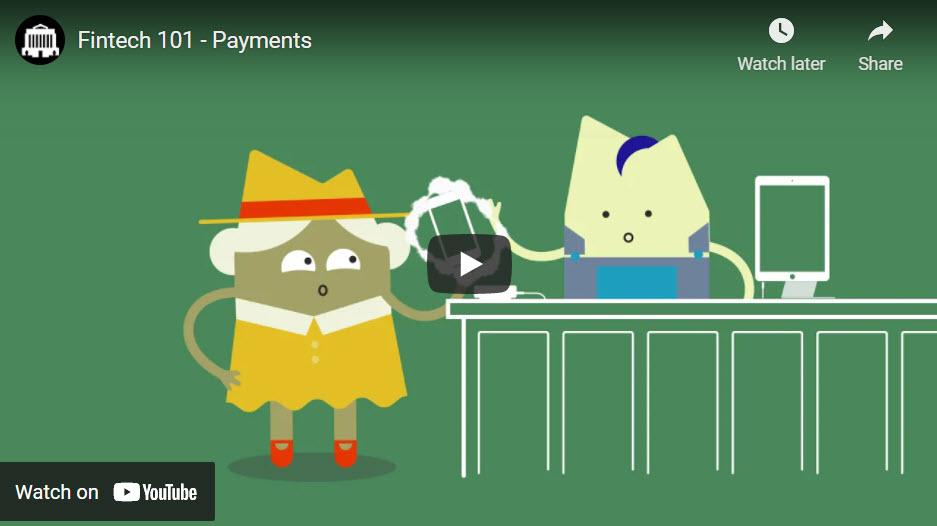
https://www.youtube.com/watch?v=Wyw6iJBqEdk
Looking forward
In 2022, the Bank will:
- develop the supervisory framework for retail payments, engaging with industry stakeholders on its design and implementation
- prepare its operations for when the Act and its regulations come into force
- broaden its outreach to raise awareness of this new regulatory regime
On this page

Currency
The COVID‑19 pandemic continued to affect the Bank’s currency operations in 2021.
Demand for cash returned to normal levels after an unprecedented high in 2020. Meanwhile, the counterfeit rate, at 7 parts per million, remained well below the Bank’s target of 30 parts per million.
The Bank conducted research into the pandemic’s impact on the use of cash and other payment methods. This helped staff gain a deeper understanding of how Canadians’ payment preferences are evolving and provided insight into the potential role of a central bank digital currency.
Meeting Canadians’ demand for cash
The demand for cash returned to more normal levels in 2021 after reaching extraordinary highs in 2020 because of the pandemic. Throughout 2021, the Bank’s Agency Operations Centres and bank note distribution system together ensured the uninterrupted supply of cash to financial institutions across the country.
Conducting research to inform the Bank’s currency function
Bank staff undertake ongoing research to shed light on different aspects of the Canadian payments landscape. In 2021, the impact of the pandemic on the demand for bank notes was a particular focus.
Staff explored the use of cash and digital currencies and conducted surveys to explore how Canadians’ payment preferences are evolving. Notably, survey results indicated that 80% of Canadians intend to continue to use cash over the next five years.
#DYK: In our latest survey on cash demand, 80% of Canadians said they have no plans to go cashless in the next 5 years. #cdnecon #economyhttps://t.co/N2kEqAIyoP pic.twitter.com/4xkIOcdhJR
— Bank of Canada (@bankofcanada) August 26, 2021

https://twitter.com/bankofcanada/status/1430962725954498565
Other areas of economic research included:
- access to cash in Indigenous communities in Canada
- consumer adoption and merchant acceptance of various payment methods
Staff also conducted laboratory experiments to understand the potential implications if Canada were to adopt a central bank digital currency.
The Bank also continued researching new security features for future bank notes.
Designing the next $5 note
In 2020, eight iconic Canadians were shortlisted to appear on the next $5 bank note. The Minister of Finance will make the final decision on the portrait subject. The new $5 note will be vertical, like the current $10 note, and will be printed on polymer.
On #InternationalWomensDay, meet the women on the short list for the next $5 bank note. https://t.co/qfFG2vHOYD
— Bank of Canada (@bankofcanada) March 8, 2021

https://twitter.com/bankofcanada/status/1368919131257532425
Looking forward
In 2022, the Bank will:
- expand its research on the use of cash and digital currencies
- further build its capacity to issue a central bank digital currency, should the need arise
- continue its research into security features for future bank notes
- continue work on the next $5 bank note, subject to a final decision by the Minister of Finance on the portrait subject
On this page

Preparing for a central bank digital currency
In 2021, the Bank continued to build its capacity for issuing a central bank digital currency (CBDC)—a digital form of money the central bank would make available to all Canadians. Given that legislative amendments would be required, any decision to issue a CBDC in Canada ultimately rests with Parliament. And, although no such decision has been made, the Bank is committed to being ready to issue a CBDC should the need arise.
As part of this commitment, the Bank made progress in several areas.
For leading research on #fintech and central bank digital currency, we have you covered https://t.co/NXU0KbYez1 pic.twitter.com/xE0bwf5jgF
— Bank of Canada (@bankofcanada) August 11, 2021

https://twitter.com/bankofcanada/status/1425450168728625153
Improving technical understanding of possible designs
The anticipated features of a CBDC—universal accessibility, privacy, compliance, security and resilience—would be challenging to achieve. In 2021, the Bank made progress on the possible conceptual and technical designs of a CBDC. Collaborating with academics and specialists, the Bank investigated novel technologies, such as advances in cryptography, to:
- balance privacy with compliance requirements
- achieve the highest degree of security
This work must consider the pace of technological development, including the possibility that, in the future, quantum computers could challenge current security techniques.
The Bank also focused on expanding its expertise on accessibility issues. That’s because the Bank strives to ensure that all Canadians—regardless of their personal circumstances—could use a CBDC if they wanted to. And it engaged three project teams from Canadian universities to develop fresh ideas on CBDC design independently of the Bank.
Monitoring the evolution of the Canadian payments landscape
Overseeing the rapidly evolving payments system helps the Bank determine whether the need to issue a CBDC might arise. This includes keeping track of new forms of digital money, such as stablecoins and CBDCs issued in other countries. In 2021, the Bank established a framework to support this process.
To reinforce its currency and payments functions, the Bank regularly conducts research exploring the Canadian payments landscape. This includes ongoing work to understand the:
- demand for and use of cash
- potential implications of a CBDC
- use and evolution of digital currencies and financial technologies (fintech)
Through models and laboratory experiments, staff conducted research on two-sided payment markets. This work will help the Bank estimate the likelihood of adoption of a CBDC. Researchers also used survey and administrative data as well as non-traditional data sources to better understand how a CBDC would compare with cash.
Toward the end of 2021, the Bank launched a project to explore the potential value proposition of a CBDC for consumers. This work reflects the Bank’s ongoing commitment to ensure Canadians have an opportunity to share their views on this issue.
ICYMI: If one day a “digital loonie” is needed and the public wants one, Deputy Governor Lane says there are some good reasons that it should be provided by a central bank—a trusted public institution. #cdnecon #economy https://t.co/0DjK0gDAQd pic.twitter.com/dhWh0mFxPJ
— Bank of Canada (@bankofcanada) February 11, 2021

https://twitter.com/bankofcanada/status/1359940459125239811
Engaging with federal institutions and financial sector stakeholders
As part of its preparation, the Bank worked closely with the Department of Finance Canada to consult with:
- relevant Government of Canada departments
- other federal government agencies
- a range of financial institutions
This outreach, although still in the early stages, is helping the Bank improve its understanding of the broader implications of a CBDC—including for the financial sector.
ICYMI: We are working with the Bank for International Settlements and 6 central banks to explore central bank digital currencies for the public. Read about our latest work: https://t.co/qa5VupX8vi
— Bank of Canada (@bankofcanada) October 1, 2021

https://twitter.com/bankofcanada/status/1443958883005960192
Contributing to international planning and dialogue
The Bank made important contributions in 2021 to international discussions about CBDCs. It continued its work with a coalition of other central banks and the Bank for International Settlements to identify and reflect on the most effective design elements of a CBDC. These discussions led to the publication of three reports in September on:
In addition, this same group of central banks worked with their finance ministry counterparts on the publication of a:
Looking forward
In 2022, the Bank will:
- continue research and analysis to better understand the potential benefits and risks of issuing a CBDC.
- engage further with external stakeholders to gather their views, and conduct research on the public’s awareness and understanding of issues associated with CBDCs.
- further its technical investigations into possible design choices. In addition to more detailed policy analysis, this will involve experimental work in collaboration with other central banks and experts outside the Bank to help identify design options for meeting relevant public policy objectives.
On this page

Managing the Bank
Throughout 2021, the Bank closely monitored the COVID‑19 pandemic. In autumn, following widespread vaccination across Canada, the Bank was able to begin transitioning out of a crisis-response mode. As part of this work, the Bank made significant progress in designing and planning its post-pandemic work environment.
At the same time, the Bank remained focused on enhancing its resilience and continuing its digital transformation. These efforts will ensure it remains a leading central bank, ready to take on the future of work in an increasingly digital world.
Launching the Bank’s new values and promise to Canadians
In 2021, the Bank shared its updated core values with staff and developed a new promise statement to anchor them: Canadians count on us. The Bank’s core values are:
- think ahead
- include everyone
- inspire confidence
These values are built on the principles that have always guided the Bank: excellence, integrity and respect. They will support the Bank’s vision and culture and will be linked to every aspect of the Bank’s work—not only the work that all Canadians see, but also the way Bank staff do their work and collaborate every day.
Through the year, the Bank’s refreshed values were embedded in its leader and core competencies, Code of Business Conduct and Ethics and related learning programs. They were also used to develop the 2022–24 strategic plan, which places significant focus on people.
Focusing on our people
Named in 2021 as one of Canada’s Top 100 Employers for the 12th consecutive year, the Bank prides itself on a people-first philosophy and a top-notch work environment. In 2021, the Bank was also recognized as one of:
- Canada’s Top Family-Friendly Employers
- Canada’s Best Diversity Employers
- the National Capital Region’s Top Employers
We’re honoured to be named a top diversity employer for 2021 and proud that the steps we take to be diverse and inclusive make us a leading central bank. To join our team, see our current job opportunities: http://ow.ly/cj5f50DMSbF March 2, 2021

https://twitter.com/bankofcanada/status/1366765555286482944
Adopting new ways of working
In April, Governor Macklem announced that after the pandemic the Bank will adopt a hybrid workplace model. This approach was developed following extensive benchmarking and consultations with employees.
While most Bank staff continued working remotely throughout 2021, the Bank took important steps to support staff and prepare them for a safe and productive return to the office in 2022.
The Bank:
- continued to invest in employees’ mental health—including through enhanced policies and benefits—and offered additional financial support to enable employees to improve their home offices
- engaged staff in designing their post-pandemic work environment and provided communications, coaching and resources to prepare them for the return to onsite work
- began adapting its physical spaces and technologies to support new ways of working
- implemented a mandatory vaccination policy and verification process in line with federal government directives
Evolving the Bank’s diverse workforce
The Bank implemented a range of initiatives in this final year of its first diversity and inclusion strategy. Efforts included:
- improving representation of employees from designated groups under the Employment Equity Act, including persons with disabilities (up from 5.2% of staff in 2020 to 7.7% in June 2021) and racialized persons (up from 26% in 2020 to 29.7% in June 2021)
- awarding its first scholarship for members of racialized groups, with two recipients selected from over 1,000 applicants in the award’s inaugural year
- introducing training on conscious inclusion and Indigenous cultural awareness for all employees
Congratulations to our scholarship winners! We’re excited to be #AbleTo support students on their path to success #WomenInEconomics, #IndigenousEducation, #Indspire, #PWD, #diversity http://ow.ly/2sHR50DCzP5February 17, 2021

https://twitter.com/bankofcanada/status/1362042093611470849
On September 30, the Bank observed Canada’s first National Day for Truth and Reconciliation. Activities included a blog post by embRACE—an employee resource group of Black, other racialized and Indigenous employees and their allies—about the importance of reconciliation.
The Bank continued its role as an international leader in diversity and inclusion. Along with other central bank partners, it co-hosted a virtual conference on diversity and inclusion in economics, finance and central banking. The Bank of Canada and the other G7 central banks also committed to working proactively to improve diversity and inclusion within their own organizations and their financial systems.22
With an eye to the future, the Bank enlisted the help of employees in the development of a new diversity and inclusion strategy for 2022–24.
Happy #Pride Month! We’re proud to stand with our LGBTQ2S+ colleagues as we work towards creating a more equitable and inclusive workplace where everyone feels comfortable being their true selves.June 18, 2021

https://twitter.com/bankofcanada/status/1405888950888247302
Enhancing resilience and preparing for what lies ahead
Despite many pandemic-related challenges, staff remained resilient in 2021. They focused on core work, made progress on major initiatives and ensured that operations continued to run smoothly. Through their efforts, the Bank was able to deliver on its mandate.
Throughout the year, the Bank:
- continued to reinforce the resilience of its systems and tools
- strengthened its cyber security capabilities
- advanced its digital transformation
- persisted in reducing its environmental impact
The Bank’s innovative approach to integrating digital technologies into its operations is an important part of what makes it a leading central bank.23
Enhancing the systems and tools that support operations
Significant effort was made to support and maintain the Bank’s operational systems. In addition, the Bank completed several resilience initiatives and evergreening activities to further enable effective monitoring and management of its critical systems. It also provided new collaboration, networking and other tools to ensure employees working from home could remain engaged and effective.
At the same time, it began implementing the required tools and technical support that will be key to the new ways of working in a hybrid approach.
Strengthening the Bank’s cyber security posture
The Bank enhanced its resilience capabilities to manage cyber security risks to the Bank itself and to the Canadian financial system.
Internally, the Bank developed a new cyber security strategy. Given the competitiveness of the cyber security labour market, attracting and retaining diverse and qualified employees remained a focus.
Externally, the Bank continued its work with the Canadian Financial Sector Resiliency Group—a public-private partnership that brings together Canada’s systemically important financial institutions and regulators. In 2021, the group developed and tested a crisis coordination playbook.
The Bank also continued to lead the cyber-related work of the Resilience of Wholesale Payments Systems (RWPS) initiative with Canada’s six largest commercial banks and Payments Canada. The RWPS conducted regular cyber exercises and worked with financial sector participants to complete two self-assessments of the wholesale payments system’s controls.
#Economics or #finance grad? Here’s why you should apply to the Bank of Canada! Our University Recruitment Campaign runs until October 11. #graduate #jobs http://ow.ly/hHZM50GiB9xSeptember 29, 2021

https://twitter.com/bankofcanada/status/1443192802817478669
The Bank’s digital transformation
The Bank continued to implement its digital transformation strategy and enhance its data and analytics capabilities. Staff used automation and advanced analytics to:
- improve key processes and tools
- develop dashboards for decision makers
- enhance reporting
As part of this work, staff used digital technologies to modernize monitoring and projection activities and streamline processes that support monetary policy decisions.
The Bank continued to update its data and information platforms and tools, while at the same time enhancing its data capabilities and expertise. One such activity was establishing a new data lake, which will improve the Bank’s ability to leverage a wide variety of data.
In addition, among its new learning programs, the Bank launched one to enhance data literacy for leaders. This was in response to the results of a 2020 strategic workforce planning exercise that identified critical skills for the future.
The Bank also renewed its cloud strategy and furthered its transition to cloud-based services, as appropriate, in a secure and resilient manner. Notably, it made public cloud-computing platforms the preferred deployment model for all information technology services. This approach enables the Bank to deliver new digital platforms and services to employees, while ensuring its infrastructure remains agile enough to continue meeting business needs well into the future.
Greening the Bank’s operations
The Bank took important steps in 2021 to measure and reduce its carbon footprint as well as to integrate climate change into planning and decision making.
Looking forward
In 2022, the Bank will:
- implement its new hybrid workplace model and:
- support staff through their return to onsite work by offering training, technologies and other resources
- monitor the impact on the Bank’s work environment and culture
- complete a thorough review of relevant Bank policies to ensure they are aligned with diversity and inclusion and new ways of working
- continue to provide employees with opportunities to develop key skills for the future
- begin implementing the 2022–24 diversity and inclusion strategy and move forward on new pay equity regulations
- continue to work with central bank partners to promote diversity and inclusion, and host the next conference on diversity and inclusion in economics, finance and central banking
- transition business-critical applications to the Bank’s new secure information technology infrastructure
- expand the use of data and digital technologies throughout the Bank
- 22. Bank of England, “G7 Finance Track—Central Bank Governors Meeting: Chair’s Statement on Diversity and Inclusion, December 2021,” press release (December 3, 2021).[←]
- 23. For more information, see D. Zarum, “How a CPA Is Helping to Accelerate the Bank of Canada’s Digital Future,” Pivot Magazine (August 10, 2021).[←]
On this page

Communications and outreach
As the pandemic entered its second year, the Bank’s communication efforts remained focused on explaining the extraordinary measures put in place to foster economic recovery. The Bank also began laying out its plans for adjusting monetary policy as the economy returns to its full potential.
As it does every five years, the Bank renewed its monetary policy framework agreement with the Government of Canada. The renewal of the framework followed three years of research and engagement with Canadians. It provides continuity and clarity and addresses important changes in the economy. With inflation well above the target, the renewed agreement was an important opportunity to reaffirm price stability as the primary goal of monetary policy, while also articulating the flexibility inherent in the framework.
While the pandemic made stakeholder and public engagement more difficult, the Bank continued to expand and deepen its outreach, particularly on the topics of:
- the economic impacts of COVID‑19
- the renewal of Canada’s monetary policy framework
- retail payments supervision
The Bank also continued its efforts to improve relationships and enhance collaboration with Indigenous Peoples.
In 2021, the Bank introduced its new Senior Deputy Governor, Carolyn Rogers, to Canadians. It also announced the appointment of a new Deputy Governor, Sharon Kozicki, as well as the first Executive Director for Retail Payments Supervision, Ron Morrow.
Being transparent and fostering understanding
For the past several years, the Bank has improved how it communicates so that it can help Canadians understand what it does. This goal guided its communications more than ever in 2021.
The Bank remained committed to communicating in easy-to-understand, relatable language. It used a range of channels, including:
- speeches
- media interviews
- web content
- social media
- educational materials
- stakeholder consultations
Speech summaries
Throughout the year, the Governor and other members of Governing Council spoke regularly about the programs the Bank put in place during the pandemic. They also shared the Bank’s expectations for how the recovery is likely to unfold. Alongside every speech, the Bank published a plain language summary to highlight the speech’s key messages.
Explainers
In 2021, the Bank published new explainers—brief articles that translate complex ideas into everyday language—on several topics, including:
- monetary policy
- the target for the overnight rate
- the consumer price index
The Bank also created a dashboard on its website to show the progress of the labour market recovery.24
Financial System Hub
The Bank used its Financial System Hub to share articles of public interest on financial stability issues. In 2021, new content focused on:
- housing market imbalances and household indebtedness
- the impact of the COVID‑19 pandemic on the financial health of Canadian businesses
- climate-related risks
Data accessibility
As part of its ongoing efforts to promote transparency, the Bank made its data more accessible. Specifically, it improved its Valet API—a tool integrated into the Bank’s website that allows people to easily retrieve data. Users accessed the API more than 11 million times in 2021. The Bank also published transaction-level data for the asset purchase programs it established early in the crisis and later discontinued.
Bringing the Museum to Canadians
The Bank of Canada Museum was closed to visitors for 2021 because of the pandemic. However, it continued to reach thousands of Canadians by:
- offering lesson plans and other educational materials to teachers at the primary and secondary levels
- participating in several teachers’ conferences to consult with educators across the country
- making kids’ activities available through its website and social media
- organizing a virtual speaker series in which experts discussed topics related to the economy
Looking for #free teaching resources about money and economics? Want to stay up to date on our educational programs and activities? Sign up for our educators’ #newsletter and the information will come to you! #EconEd #cdned https://t.co/sDf42eeMLW pic.twitter.com/Ul1PH6gKcL
— Bank of Canada Museum (@BoCMuseum) April 5, 2021

https://twitter.com/BoCMuseum/status/1379041441779957766
Involving Canadians in the Bank’s work
To better serve Canadians, the Bank actively engages with them—particularly when its policies and initiatives have the greatest potential to affect them.
Understanding Canadians to serve them better
In 2021, the Bank conducted public opinion surveys and focus groups to understand how Canadians perceived its work during the pandemic. It used the results to adapt its communications to the public’s needs and preferences.
Public trust in the Bank remained solid. Compared with pre-pandemic numbers, more Canadians believed that the Bank’s decisions are relevant to them.25
Publishing the results of our consultations on inflation and the monetary policy framework
After concluding broad public consultations in the lead-up to the renewal of the monetary policy framework, the Bank published a detailed report summarizing what it heard from Canadians—including their perceptions on inflation.
Expanding consultations and engagement activities with key stakeholders
To further its understanding of how its policies affect specific groups of Canadians, the Bank continued to expand its targeted engagement activities. For example, it held round-table meetings with:
- labour groups
- civil society organizations
- business and trade associations
These were used to discuss the impact of COVID‑19 and how the economy will look in the aftermath of the pandemic.
In 2021, the Bank co-founded the Central Bank Network for Indigenous Inclusion with its Indigenous partner organization, the Tulo Centre of Indigenous Economics,26 and consulted with other Indigenous organizations, such as the First Nations Finance Authority, to understand how monetary policy affects their members. In November, the Bank collaborated with the Tulo Centre and the Reserve Bank of New Zealand to host the first Symposium on Indigenous Economies. The symposium featured 51 speakers and was attended by 425 participants.
The Bank also significantly expanded its outreach related to a central bank digital currency and retail payments supervision.
The pine needle basket was selected by Sarah Jules of @TuloCentre. The coiled pattern evokes spirals found in cultures around the world – a symbol of change and development. It contains a stone from Meech Lake, in traditional unceded Algonquin territory. (2/3) pic.twitter.com/8edSjTknyw
— Bank of Canada (@bankofcanada) December 1, 2021

https://twitter.com/bankofcanada/status/1466102178431610887
Promoting and supporting research
The Bank engaged with academics, research partners and students through a variety of initiatives, conferences and programs.
The Bank also highlighted current research through a monthly newsletter and website.
Looking forward
To ensure it remains a relatable and trusted Canadian institution, the Bank will:
- continue to increase its accountability and relevance through clear, accessible communications
- engage directly with a broader set of stakeholders to better understand their diverse points of view
- raise public awareness of the Bank’s emerging areas of responsibility
- expand the scope and reach of its educational programming about the economy
- continue to offer virtual programs for schools and reopen the Bank of Canada Museum, offering in-person programs when public health restrictions have been lifted
- work with a broad spectrum of Indigenous groups to develop a reconciliation action plan for the Bank
- work to ensure the Bank’s content and events meet or exceed the requirements set out in the Accessible Canada Act
- 24. Bank of Canada, “Labour Market Recovery from COVID‑19.”[←]
- 25. Learn more about the results of the Bank’s Public Awareness Surveys.[←]
- 26. Bank of Canada, “Bank of Canada Becomes Inaugural Member of New, International Central Bank Network for Indigenous Inclusion” (press release, April 27, 2021).[←]
On this page

Global engagement
In 2021, the Bank focused its international efforts on:
- the global macroeconomic policy response to the evolving impacts of the COVID‑19 pandemic
- global policies related to climate change and the digitalization of the economy
- the future of the international monetary and financial system
- promoting and reinforcing the resilience of the international financial system
Steering the global economic recovery
To support price stability and the global economic recovery from the pandemic, the Bank promoted the importance of striking the right balance of policies.
The Bank worked with its global counterparts,27 emphasizing the need to:
- monitor inflation dynamics closely
- look through pressures that were transitory
- act as needed to achieve their mandates
- communicate clearly about their policy stances
Collaborating to address shared global challenges
Policy-makers expressed renewed resolve to strengthen multilateral cooperation while tackling global challenges.
- Climate change: For the first time, both the G7 and the G20 presidencies included climate action among their top global policy priorities. The Bank’s work on climate transition scenarios illustrates the importance of transition financing for all sectors to achieve a smooth shift to a low-carbon economy. The G20 agreed that more systematic analysis is needed to assess macroeconomic risks stemming from climate change.
- Digitalization: The rapid increase in digital activity during the pandemic highlighted the need for actions across countries that take advantage of the benefits of digitalization and ensure those benefits are broadly shared.
- The Bank leveraged staff research on automation to show how digitalization may also reduce jobs and displace workers, illustrating the need for policies to support those who lose their jobs.
- The Bank continued to chair the G7 Central Bank Digitalization Working Group. Members discussed:
- the likelihood that pandemic-related digital shifts in behaviour (such as widespread remote work) will persist
- how such shifts affect central banks’ estimates of productive capacity and the labour market
- G7 finance ministers and central bank governors discussed shared priorities for ongoing work promoting the cyber security and resilience of the financial sector—issues that are increasingly relevant in a more digital world.
- The G7 released a statement on shared principles for central bank digital currencies and digital payments.
Calling for action on the international monetary and financial system
In his first international speech, Governor Macklem called for global cooperation on one of the most enduring central bank challenges: the future of the international monetary and financial system.
The Governor urged the international community to ensure that managing immediate crises does not come at the expense of making longer-term adjustments that will raise productivity and standards of living. Improving prosperity in the long term requires steady progress toward liberalization and a commitment to sound macroeconomic and financial policy frameworks.
The Governor also noted that the system must evolve to be able to handle future changes, including the:
- exit from exceptional monetary policy
- transition to net-zero emissions
- potential digitalization of the international monetary system
This work will be critical in the aftermath of the pandemic.
On October 7, Governor Tiff Macklem will give a virtual speech before @CFR_org on the rules of the international monetary and financial system. #economy #cdnecon https://t.co/hfIyFTUXXH pic.twitter.com/fRLJWTwPfP
— Bank of Canada (@bankofcanada) October 4, 2021

https://twitter.com/bankofcanada/status/1445099268910501891
Promoting financial system resilience
Following the global financial crisis of 2007–09, authorities addressed key vulnerabilities in the banking system by revamping the global regulatory framework. The Basel III standards are the most recent reforms aimed at improving the resilience of banks around the world to financial stress.28
In this context, the Bank co-chairs the Task Force on Evaluations, under the umbrella of the Basel Committee on Banking Supervision. This task force analyzes the effectiveness of Basel III reforms.
In 2021, the task force published a report assessing how the Basel III reforms contributed to reducing the stress the pandemic placed on the global banking sector.29 The Bank also collaborated on publishing the final report evaluating the too-big-to-fail reforms endorsed by the G20 after the global financial crisis.30
Governor Macklem is an active member of the Standing Committee on Assessment of Vulnerabilities of the Financial Stability Board (FSB). This committee monitors and assesses vulnerabilities affecting the global financial system. In 2021, it published a new surveillance framework for identifying global financial vulnerabilities.31
The market turmoil in March 2020 highlighted the need to strengthen the resilience of non-bank financial intermediation (NBFI). Doing so would ensure a more stable flow of financing to the economy and reduce the need for central banks to undertake extraordinary interventions. In 2021, the Bank was actively involved in many elements of the ambitious FSB work program on NBFI.32
Strengthening the payments ecosystem
The Bank helped develop the international roadmap for enhancing cross-border payments, and in 2021 it continued to play an active role in the roadmap’s implementation. The aim of this global effort is to make cross-border payments cheaper, faster, more inclusive and more transparent.
The Bank also worked with international partners to promote the soundness of global stablecoins. It chairs the FSB working group on regulatory issues of stablecoins, which makes recommendations on their regulation, supervision and oversight. In 2021, the Bank contributed to an assessment of the progress made against recommendations drafted in 2020 and to a consultative report on the application of the CPMI-IOSCO Principles for Financial Market Infrastructures to global stablecoins.33, 34
We are collaborating with international partners to address the pain points in cross-border payments, and we’re fully committed to working with the public and private sectors to make any necessary changes in Canada to support this.May 31, 2021

https://twitter.com/bankofcanada/status/1399458010985111556
Looking forward
In 2022, the Bank will continue to:
- prioritize the highest-value international activities that leverage our Canadian advantage
- further integrate research into our global policy work
- explore the potential to build coalitions with a diverse set of partners to enhance Canada’s global influence
- advocate for greater investment in strengthening the international monetary and financial system to handle or facilitate future transitions
- lead international efforts to evaluate the effectiveness of Basel III reforms for banking sector resilience
- support the implementation of the FSB roadmap for cross-border payments
More information
Progress Report on Adoption of the Basel Regulatory Framework
- 27. Italian G20 Presidency, Fourth G20 Finance Ministers and Central Bank Governors meeting (Communiqué, October 13, 2021).[←]
- 28. T. Gomes, S. King and A. Lai, “Shoring Up the Foundations for a More Resilient Banking System: The Development of Basel III,” Bank of Canada Financial System Review (November 2017): 35–42.[←]
- 29. Basel Committee on Banking Supervision, Early Lessons from the COVID‑19 Pandemic on the Basel Reforms (Bank for International Settlements, July 2021).[←]
- 30. Financial Stability Board, Evaluation of the Effects of Too-Big-to-Fail Reforms: Final Report (March 2021).[←]
- 31. Financial Stability Board, FSB Financial Stability Surveillance Framework (September 2021).[←]
- 32. Financial Stability Board, Enhancing the Resilience of Non-Bank Financial Intermediation: Progress Report (November 2021).[←]
- 33. Financial Stability Board, Regulation, Supervision and Oversight of “Global Stablecoin” Arrangements: Progress Report on the Implementation of the FSB High-Level Recommendations (October 2021).[←]
- 34. Committee on Payments and Market Infrastructures and Board of the International Organization of Securities Commissions (CPMI-IOSCO), Application of the Principles for Financial Market Infrastructures to Stablecoin Arrangements (Bank for International Settlements and International Organization of Securities Commissions, October 2021).[←]
On this page

Advancing the Bank’s climate change work
Climate change poses significant risks to the economy and financial system. In 2021, the Bank deepened its understanding of these risks and continued its efforts to reduce its carbon footprint and manage climate-related risks to its operations.
The Bank announced its climate change commitments as the 2021 United Nations Climate Change Conference (COP26) was unfolding in Glasgow, Scotland.35
ICYMI: Deputy Governor Paul Beaudry explains why it’s important for us to understand the climate-related risks to our financial system. #cdnecon #economy https://t.co/DHXsPdMNdO pic.twitter.com/MH8IwlUSYQ
— Bank of Canada (@bankofcanada) November 25, 2021
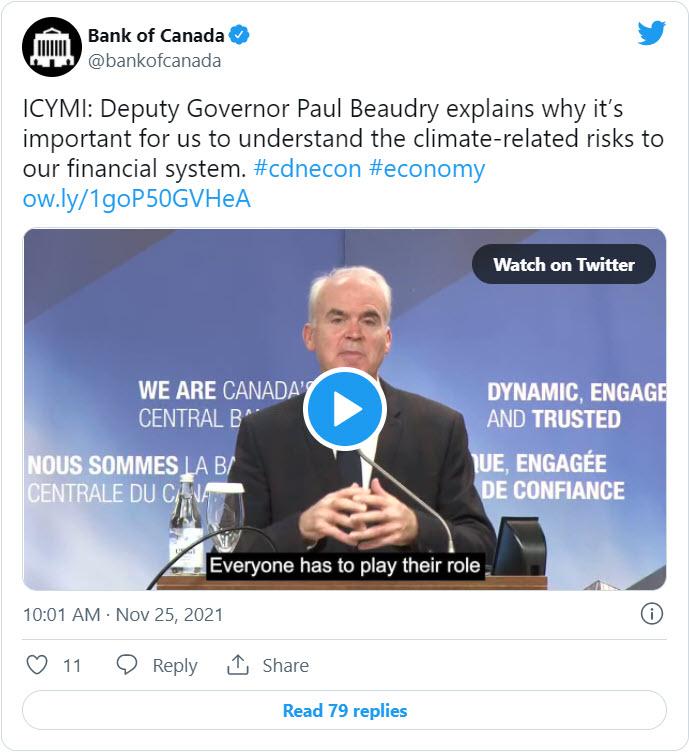
https://twitter.com/bankofcanada/status/1463885509487480832
Fulfilling the Bank’s mandate in a changing climate
Climate change has implications for the Bank’s mandate. In 2021, the Bank devoted significant resources to assessing these implications.
Exploring how climate change could affect the economy and price stability
Bank staff continued to research how climate change and transitioning to a low-carbon economy could affect:
- the economy
- inflation
- jobs
This work included developing Canadian macroeconomic scenarios, which are useful for identifying potential risks in an environment of considerable uncertainty.
The Bank also began integrating climate considerations into its macroeconomic simulations. This helped the Bank better define what climate change might mean for the Canadian and global economies. In undertaking this cutting-edge work, the Bank became the first central bank to assess transition risks by combining climate-economy models with macroeconomic models.
Gauging how climate change could affect the financial system
Climate change also poses important risks to individual participants within the financial system as well as to the overall stability of the system. Physical climate risks from extreme weather events can expose households to financial stress, especially households that are already financially vulnerable.
The 2021 Bank of Canada Financial System Review summarized research that combined data on regional exposure to climate-related natural disasters with data on the geographic distribution of household financial vulnerabilities. This work helped researchers recognize how climate-related natural disasters—depending on where they occur—can have varying implications for the economy and financial system.
The transition to a low-carbon economy also poses climate risks to the financial system. Because asset prices may not correctly reflect these risks, they are subject to potentially large repricing.
The Bank worked with the Office of the Superintendent of Financial Institutions and six Canadian financial institutions to complete a pilot project that used climate scenarios to assess transition risks.36
The project successfully met its goals to:
- increase understanding of the financial sector’s potential exposure to climate transition risks
- help the Canadian financial sector improve its assessment and disclosure of climate-related risks
- build the capability of financial institutions and authorities to conduct climate scenario analysis
The project also improved authorities’ understanding of the practices that financial institutions have put in place to govern and manage risks and opportunities related to climate change.
The Bank’s scenario work was part of a global effort. Many central banks and supervisors that, with the Bank, are members of the Network for Greening the Financial System conducted similar climate scenario exercises in 2021.
We recognize the importance of including #climatechange considerations in our work to promote the economic and financial welfare of Canadians. Read our pledge. #cdnecon #economy #COP26 https://t.co/Y12kKYVlno
— Bank of Canada (@bankofcanada) November 3, 2021

https://twitter.com/bankofcanada/status/1455878701971816448
Contributing to international dialogue on climate risks
In 2021, leaders from around the world renewed their commitment to tackling climate change. The Bank played a key role in many important discussions.
For the first time, both the G7 and G20 presidencies included climate action among their top global policy priorities. Central bank governors agreed that more systematic analysis is needed to assess macroeconomic risks stemming from climate change. They also committed to analyzing the costs and benefits of different paths to achieving net-zero emissions in greater detail.
The Bank actively contributed to this dialogue and regularly collaborated with many international partners on these issues:
- The Bank sits on the steering committee for the international Central Banks and Supervisors Network for Greening the Financial System. In this role, the Bank helps guide the network’s efforts, particularly those related to evaluating the impacts of climate transition on countries with large resource sectors, such as Canada. The Bank used its influence and expertise in this area to promote a scenario-based approach to the disclosure of climate-related risks.
- The Bank also worked with other international bodies, including the Financial Stability Board (FSB). It played an important role in the FSB’s work on climate-related financial risks.
- As a member of the G20 Sustainable Finance Working Group, the Bank contributed to a sustainable finance roadmap. The roadmap establishes a plan for ramping up the sustainable finance needed to speed up the implementation of the Paris Agreement from both private and public sources.
“LEED Gold to be achieved through a 50-year-old all-glass building is a huge endeavour.” Check out this @CentralBanking_ article to learn about some of the changes we’ve made to reduce our carbon footprint @USGBC #cdnecon #economy https://t.co/Zj7UAuxnEp
— Bank of Canada (@bankofcanada) May 5, 2021

https://twitter.com/bankofcanada/status/1389943527241654274
Reducing the Bank’s environmental footprint
In 2021, the Bank continued to take important steps to:
- measure and reduce its own carbon footprint
- integrate climate change into planning and decision making
To fulfill its 2020 commitment to achieving net-zero operational carbon emissions by 2050, the Bank identified the primary operational areas to be targeted. It also established preliminary action plans for their decarbonization, including a roadmap for reducing emissions in its facilities by:
- 40% by 2025
- 80% by 2030
The Bank also completed site assessments of all the buildings it owns. These assessments will be followed by environmental engineering studies to identify opportunities for significant improvements in energy, waste and water consumption. In addition, the Bank signed an agreement with a clean energy provider to shift to 100% renewable electricity in 2022.
The Bank committed to:
- achieving near-zero water consumption across the buildings it owns by 2035 or sooner
- achieving near-zero waste across the buildings it owns, diverting 75% of operational and plastic waste and 100% of construction waste by 2030
It is also working to integrate environmental, social and governance principles into managing the Bank of Canada Pension Plan.
#EarthDay reminds us that the natural #environment is a defining feature of our economic prosperity. Learn about the changes we’ve made to our operations to reduce our carbon footprint. #cdnecon https://t.co/AEJfhDEfbY pic.twitter.com/LP9lTjCrga
— Bank of Canada (@bankofcanada) April 22, 2021

https://twitter.com/bankofcanada/status/1385217434064408582
Disclosing exposures to climate-related risk
Like all organizations, the Bank faces a variety of risks associated with climate change.
In 2021, the Bank began developing a framework to measure and report its own exposure to climate-related risk. This framework will enable the Bank to more comprehensively assess risk exposures and is aligned with the recommendations of the Task Force on Climate-Related Financial Disclosures.
In 2022, the Bank will begin work on reporting its climate-related financial risks. It will use its climate risk framework and draw on best practices and the experiences of other central banks to draft its report. These are described in the Network for Greening the Financial System Guide, which the Bank contributed to in 2021. The Bank hopes that publication of this report encourages other financial institutions to disclose their own exposure to climate risks.
Looking forward
In 2022, the Bank will:
- continue to assess the economic and financial effects of climate risks
- contribute to the work of the Network for Greening the Financial System, focusing on:
- refining and promoting the use of climate-change scenarios for the disclosure of climate risks
- identifying and addressing data gaps
- providing advice on best practices for market transparency related to climate change
- continue to steer the global policy dialogue on climate change
- implement decarbonization action plans for targeted operational areas, including:
- completing environmental engineering studies of all Bank-owned buildings and addressing immediate opportunities
- embedding sustainability considerations into procurement processes
- establishing baseline metrics for greenhouse gas emissions, water consumption and waste for bank note operations
- launching an education and awareness program about business travel and commuting to work
- work toward publishing a report that follows the recommendations of the Task Force on Climate-Related Financial Disclosures
- analyze, including through consultations, options for integrating climate change considerations in the design of market operations
- 35. Bank of Canada, “Bank of Canada Announces Climate Change Commitments for COP26” (press release, November 3, 2021).[←]
- 36. Bank of Canada, “Assessing Climate Change Risks to Our Financial System” (January 14, 2022).[←]
On this page

Governance
The Bank of Canada Act provides the legal authority and framework for governance of the Bank of Canada.
Several important governance changes occurred in 2021:
- Carolyn Rogers was appointed Senior Deputy Governor of the Bank for a seven-year term, effective December 15. As Senior Deputy Governor, Ms. Rogers is a member of the Bank’s Executive Council, Governing Council and Board of Directors.
- Sharon Kozicki was appointed Deputy Governor and member of the Bank’s Executive Council and Governing Council, effective August 2.
- Ron Morrow was appointed Executive Director, Retail Payments Supervision, effective August 9. This executive-level position was created to support the Bank’s new mandate to supervise retail payment service providers under the Retail Payment Activities Act. As Executive Director, Mr. Morrow is also a member of the Bank’s Executive Council.
Most governance activities—including meetings of the Board of Directors, Executive Council and supporting subcommittees—were conducted virtually throughout 2021 because of the COVID‑19 pandemic.
A warm welcome to our new Senior Deputy Governor, Carolyn Rogers. She is officially on the job, having joined us from @BIS_org. Get to know her here: http://ow.ly/FZuo50HbP2q December 15, 2021

https://twitter.com/bankofcanada/status/1471246962401886214
Board of Directors
The Bank’s Board of Directors is composed of:
- the Governor
- the Senior Deputy Governor
- 12 independent directors
- the Deputy Minister of Finance (who is an ex officio non-voting member)
Pursuant to the Bank of Canada Act, the Governor is both:
- Chief Executive Officer of the Bank
- Chair of its Board of Directors
As Chair, the Governor leads the Board’s oversight of corporate, financial and administrative matters. Monetary policy is neither formulated nor implemented by the Board. However, directors regularly provide insight on prevailing economic conditions in their respective regions and sectors.
All independent (non-management) directors are appointed for three-year renewable terms by the Minister of Finance with the approval of the Governor in Council. The independent directors elect a lead director for a two-year renewable term. The lead director provides leadership to improve the Board’s effectiveness and acts as a key point of contact with the Governor.37 Claire M. C. Kennedy was reconfirmed as lead director in 2020 and continued in this role throughout 2021.
The Bank of Canada Act and the Conflict of Interest Act specify eligibility requirements for members of the Board and outline rules to prevent conflicts of interest.
The Board also requires its independent directors to follow the Code of Business Conduct and Ethics for Directors.
As a result of resignations in 2021, the Bank has two vacant positions on its Board of Directors. The Minister of Finance, with the Governor in Council’s approval, is expected to fill these vacancies in 2022.
See the 2021 Board of Directors
Committee structure and meetings
The Board of Directors has five standing committees, each of which has terms of reference and an annual work plan to guide its activities. The Bank of Canada Act also provides for an Executive Committee, while being accountable to the Board, to act in place of the Board. Each standing committee of the Board, except the Pension Committee, consists solely of independent directors.
Bank of Canada management
Governor and Senior Deputy Governor
The independent members of the Board of Directors appoint the Governor and Senior Deputy Governor for seven-year terms, with the approval of the Governor in Council. The length of this term allows the Governor and Senior Deputy Governor to adopt a longer-term perspective. This is essential to the Bank’s effectiveness in:
- conducting monetary policy
- performing its other core functions
The salaries of the Governor and Senior Deputy Governor are determined by the Board within ranges established by the Government of Canada’s Advisory Committee on Senior Level Retention and Compensation. They are subject to approval by the Governor in Council.
Governing Council
Pursuant to the Bank of Canada Act, the Governor:
- has specific authority and responsibility for the business of the Bank
- oversees the Bank’s core functions with assistance from the Senior Deputy Governor and the Deputy Governors
The Governor, the Senior Deputy Governor and Deputy Governors constitute the Bank’s Governing Council.
Two internal committees are in place to provide advice:
- The Monetary Policy Review Committee assesses economic conditions in Canada and provides advice to Governing Council on monetary policy.
- The Financial System Review Committee is the main forum for presenting and discussing issues related to the financial system.
Bank of Canada management structure
Executive Council—composed of Governing Council, the Chief Operating Officer (COO) and the Executive Director, Retail Payments Supervision—is responsible for assisting the Governor in oversight of the Bank’s strategic direction.

Executive Council, from left: Executive Director, Retail Payments Supervision Ron Morrow, Deputy Governor Timothy Lane, Deputy Governor Sharon Kozicki, Deputy Governor Paul Beaudry, Governor Tiff Macklem, Senior Deputy Governor Carolyn Rogers, Deputy Governor Lawrence Schembri, Chief Operating Officer Filipe Dinis and Deputy Governor Toni Gravelle.
As members of Executive Council:
- the COO oversees strategic and operational planning, administration and operations
- the Executive Director, Retail Payments Supervision, oversees the Bank’s new mandate to supervise retail payment service providers under the Retail Payment Activities Act
The Leadership Forum—composed of Executive Council, advisors and the managing directors of each department—focuses on:
- strategic Bank issues
- nurturing a leadership culture
The Senior Management Council is composed of both standing and rotating committee members from the Bank’s Leadership Forum. It supports the work of Executive Council by overseeing:
- operational issues
- corporate programs
- strategic initiatives
- financial reporting
- annual planning
- related risks
Compliance and ethics
The Bank requires that all employees observe the highest standards of professional ethics. To this end, the Bank’s comprehensive Code of Business Conduct and Ethics is in place to address the personal and professional conduct of Bank employees. The policy on disclosure of wrongdoing provides information to employees on how to report wrongdoing and outlines management’s role in disclosures, investigations and reporting.
The Code of Business Conduct and Ethics is reviewed annually by the Board.
More information
Code of Business Conduct and Ethics
- 37. See Bank of Canada, “Lead Director: Terms of Reference” (December 2020) for more information.[←]
On this page

Risk management
As the Canadian economy continued to recover from the effects of the pandemic, risk management remained central to the Bank’s decisions and policy-making activities. In particular, the Bank focused on improving the robustness and reliability of systems and processes that support its operations. At the same time, the Bank invested in its ability to foresee and manage emerging and long-term risks.
Managing risk through uncertainty
In 2021, the Bank continually reassessed the policies and programs that made up its pandemic response. As part of this process, it considered:
- its operational capacity to reliably deploy its tools
- the risks to its financial position
The Bank’s risk management framework consists of three lines of defence, which were used to:
- analyze new proposals to calibrate, terminate or introduce new measures (first line)
- ensure that proposed actions are aligned with the Bank’s risk appetite and support risk-informed decisions (second line)
- conduct regular audits to identify lessons learned in support of a broader cycle of continuous improvement (third line)
Using this framework, the Bank adapted its risk management practices to address the effects of the pandemic, which changed often and were highly complex. The framework also helped the Bank better position itself for future crises or periods of market stress.
Assessing risks to the Bank
The Bank assesses and manages four broad categories of risks:
- financial
- operational
- strategic
- environmental and climate-related
Financial risk
Throughout 2021, the Bank remained exposed to market, credit and income risks associated with the pandemic-related growth of its balance sheet. While agreements with the Government of Canada protect the Bank against some specific losses, the Bank manages these risks as its own. It continues to use various methods to mitigate them, including:
- taking securities against the lending it extends to financial institutions (or, conversely, taking cash against loans of securities)
- periodically reviewing the eligibility and value of collateral to:
- ensure that relevant market participants can access liquidity
- protect the Bank against the risk of financial loss
- conducting forward-looking scenario analyses and stress testing of the Bank’s balance sheet and income to help prepare for the future
Other potential future losses are associated with interest paid on deposits held at the Bank and their effect on the Bank’s net income. These deposits, particularly settlement balances, were significantly larger in 2021 than in the past due to the Bank’s exceptional monetary policy operations in response to the pandemic.
The Bank continued to monitor its approach to managing these risks. It also used its comprehensive risk management program established in 2020 for all special market operations.
Operational risk
The Bank’s pandemic response resulted in a significant increase in the volume and value of daily transactions and operations. Bank staff therefore needed to conduct ongoing assessments and actively manage them.
The Bank put measures in place to ensure it could securely maintain or even increase its already high level of market operations. These measures included:
- a review of resources dedicated to financial market and banking operations, which spurred an increase in the number of staff with the required skills
- upgrades to, and automation of, relevant Bank systems—including for risk monitoring and reporting—saving hundreds of hours of manual labour
- investments in information technology and processes to reduce heightened cyber risks arising from the Bank’s shift to remote work
The Bank also took steps to align itself with industry best practices and to future-proof its operations. To this end, it initiated a comprehensive assessment of the maturity of its enterprise risk management (ERM), inviting input from Bank staff and external consulting firms. Results are being integrated into a new ERM strategic plan, which will be finalized in early 2022.
Strategic risk
Strategic risks arise from external conditions, such as widespread shifts in public perceptions of central banks. The Bank continued to be exposed to such risks because of the extraordinary nature of its response to the pandemic.
To manage these risks, the Bank continually monitored the situation and provided market participants and the public with clear communication on its policy actions.
Environmental and climate-related risk
In 2021, the Bank dedicated more resources to understanding and managing climate risks. It remained actively involved internationally, helping establish best practices for central banks and other financial sector participants.
The Bank also began developing a strategy for climate risk assessment to align its financial disclosures with the recommendations of the Task Force on Climate-Related Financial Disclosures.
Looking forward
The Bank’s risk management framework will continue to guide the Bank’s efforts to support pandemic recovery. At the same time, the Bank will remain committed to improving its risk management strategy and tools.
In particular, in 2022 the Bank will:
- continue to monitor financial, operational and strategic risks arising from the current economic context and establish mitigation strategies as needed
- implement the final phases of its third-party risk management framework, which includes training, enhanced monitoring and reporting, and introducing new technologies and automation
- work toward publishing a report that follows the recommendations of the Task Force on Climate-Related Financial Disclosures and advance international standards for climate risk measurement and management
- review some components of its core risk policies and frameworks to improve its defence approach, including:
- clarifying its risk appetite for specific areas such as operational and cyber risks
- developing new risk metrics and processes for monitoring and reporting
- assigning roles and responsibilities to ensure clear accountability
On this page

Financial results
Overview
This section provides the key highlights of the Bank’s financial results for the year ended December 31, 2021. These highlights should be read with the financial statements and accompanying notes for the year ended December 31, 2021. Management is responsible for the information presented in the Annual Report.
COVID‑19: What the Bank has been doing
Since the start of the COVID‑19 pandemic, the Bank has acted in several ways to support the Canadian economy and financial system. When key financial markets became strained in March 2020, the Bank responded by introducing a number of programs to provide liquidity and maintain market functioning.
Throughout the year, the Bank continued to adjust the programs that were launched in 2020. These facilities and operations were either suspended, discontinued or scaled back. Refer to the Bank’s website for the relevant market notices and more information on these measures.
Managing the balance sheet
| Financial position (in millions of Canadian dollars) |
||
|---|---|---|
| As at December 31 | 2021 | 2020 |
Assets
|
|
| |
| Loans and receivables | 23,424 | 155,324 |
| Investments | 468,656 | 391,765 |
| Derivatives—indemnity agreements with the Government of Canada | 6,394 | - |
| All other assets* | 891 | 744 |
| Total assets | 499,365 | 547,833 |
| Liabilities and equity | ||
| Bank notes in circulation | 115,155 | 106,925 |
| Deposits | 347,034 | 436,100 |
| Securities sold under repurchase agreements | 35,560 | 3,001 |
| Derivatives—Indemnity agreements with the Government of Canada | - | 29 |
| Other liabilities | 1,008 | 1,200 |
| Equity | 608 | 578 |
| Total liabilities and equity | 499,365 | 547,833 |
* All other assets includes Cash and foreign deposits, Capital assets and Other assets.
The Bank’s holdings of financial assets are typically related to its role as the exclusive issuer of Canadian bank notes. However, the higher levels of assets in recent quarters result largely from activities undertaken as part of the Bank’s monetary policy and financial system functions. The Bank’s assets peaked in the first quarter of 2021 but began to decrease as market conditions improved. The Bank then discontinued several emergency support programs that were introduced in 2020 in response to the COVID‑19 shock. The Bank’s total assets decreased by 9% during the year to $499,365 million as at December 31, 2021. The main driver of the decline was the maturity of loans and receivables. This was partially offset by continued purchases under the Bank’s Government of Canada Bond Purchase Program (GBPP) throughout 2021.
Loans and receivables is composed primarily of securities purchased under resale agreements (SPRAs). SPRAs are high-quality assets acquired through the repo market, in line with the Bank’s framework for market operations and liquidity provision. Normally, the Bank carries out these market operations to manage its balance sheet and offset seasonal fluctuations in the demand for bank notes. The Bank began to substantially increase the scale of such operations in March 2020, with the principal aim of promoting the orderly functioning of Canadian financial markets. Starting in the middle of the first quarter of 2021, the demand for the program steadily declined, leading to its suspension in the second quarter of 2021. Compared with December 31, 2020, loans and receivables decreased by 85% to $23,424 million as at December 31, 2021, as a result of the natural maturing of SPRA operations.
Investments increased by 20% to $468,656 million as at December 31, 2021. This increase was driven mainly by the following movements within the Bank’s holdings:
- Government of Canada securities, which include nominal bonds and real return bonds, increased by $96,829 million during 2021. This growth reflects the Bank’s continued purchases under the GBPP for the majority of the year. As the Canadian economy began to improve, the Bank adjusted its quantitative easing program, by reducing its new purchases in the second quarter of 2021 and ending them entirely in the fourth quarter. The GBPP then entered into a reinvestment phase, during which the Bank will continue to purchase Government of Canada bonds to replace maturities, keeping its overall holdings stable.
- The change in the balance of Government of Canada bonds was partially offset by a decrease of $50,419 million in treasury bills, largely as a result of maturities. This change represents a decrease of 97% compared with December 31, 2020.
- The Bank engages in securities repurchase (repo) operations. These provide a temporary source of Government of Canada securities on an overnight basis to market participants. They also improve the availability of the Bank’s holdings of Government of Canada securities. The volume of securities repo operations continued to grow during 2021, resulting in an increase of $32,616 million compared with December 31, 2020.
Derivatives—indemnity agreements with the Government of Canada refers to the indemnity agreements that were put in place to allow the Bank to support provincial and corporate bond markets as well as the Government of Canada bond market. Losses resulting from the sale of assets within the GBPP, the Corporate Bond Purchase Program and the Provincial Bond Purchase Program are indemnified by the Government of Canada, whereas gains on disposal are remitted to the government. The $6,394 million balance represents the fair value of the derivatives associated with the net unrealized losses on these assets as at December 31, 2021. Long-term bond yields rose in 2021, compared with the same period in 2020, as the outlook for the economy improved. This resulted in a net decrease in the fair value of the assets held by the Bank, which in turn led to an increase in net unrealized losses on those same assets.
Bank notes in circulation represents approximately 23% (20% as at December 31, 2020) of the Bank’s total liabilities. Bank notes in circulation increased by 8% to $115,155 million as at December 31, 2021, mainly reflecting an increase in demand during the year.
Deposits consists of deposits made by the Government of Canada, members of Payments Canada and others. The balance declined by 20% to $347,034 million as at December 31, 2021, compared with December 31, 2020. While deposits are normally maintained at a lower level, they now represent the largest liability on the Bank’s balance sheet. This change stems from the purchase programs the Bank implemented in 2020 to support the Canadian economy and financial system. This balance has declined, compared with December 31, 2020, reflecting the tapering of the Bank’s extraordinary market operations.
Securities sold under repurchase agreements increased to $35,560 million as at December 31, 2021, compared with December 31, 2020. This liability represents the repurchase price for securities repo operations undertaken to support the functioning of financial markets. These operations provide a temporary source of Government of Canada nominal bonds and treasury bills to primary dealers to support liquidity in the securities financing market.
Equity includes $5 million of authorized share capital, a $25 million statutory reserve and a special reserve of $100 million. The special reserve is meant to offset potential unrealized valuation losses due to changes in the fair value of the Bank’s investments that are measured at fair value through other comprehensive income. Equity also includes an actuarial gains reserve of $43 million as at December 31, 2021. This reserve accumulates the net actuarial gains and losses on the Bank’s post-employment defined-benefit plans that the Bank recognizes following the transition to International Financial Reporting Standards in 2010. The largest reserve held by the Bank is the investment revaluation reserve, which sits at $435 million as at December 31, 2021. It represents the unrealized fair value gains in the Bank’s investment in the Bank for International Settlements (BIS). Refer to Note 14 in the financial statements for more information about the Bank’s equity.
Results of operations
| Results of operations (in millions of Canadian dollars) |
||
|---|---|---|
| For the year ended December 31 | 2021 | 2020 |
| Interest revenue | 4,022 | 3,378 |
| Interest expense | (923) | (794) |
| Net interest revenue | 3,099 | 2,584 |
| Dividend revenue | 9 | - |
| Other revenue | 7 | 6 |
| Total income | 3,115 | 2,590 |
| Expenses | 714 | 626 |
| Net income | 2,401 | 1,964 |
| Other comprehensive income (loss) | 409 | (143) |
| Comprehensive income | 2,810 | 1,821 |
Comprehensive income increased by 54% in 2021 compared with the same period in 2020. The main drivers for this growth were the increased revenue from a larger average amount of financial assets held by the Bank throughout the year as well as higher returns on assets held by the Bank’s net defined-benefit plans, coupled with an increase in discount rates.38
Interest revenue depends on current market conditions, their impact on the interest-bearing assets held on the Bank’s balance sheet, and the volume and blend of these assets. The Bank’s primary sources of interest revenue are earned on its investments and SPRAs. In 2021, interest revenue increased by $644 million (or 19%) over 2020. This increase was due to the greater average volume of assets held by the Bank throughout the year.
Interest expense consists mainly of interest incurred on deposits held by the Bank. During the year, interest expense increased by $129 million (or 16%) compared with the same period in 2020. The increase was primarily the result of a larger daily average value of deposits being held at the Bank during the 2021 fiscal year, despite a lower deposit balance as at December 31, 2021, compared with December 31, 2020.
Dividend revenue increased by $9 million in 2021 compared with 2020. The BIS did not declare a dividend in 2020.
Expenses in 2021 increased by 14% compared with 2020. For the most part, this reflects increases in staff costs and in expenditures related to bank notes.
- Staff costs increased by $40 million (or 12%) during the year, compared with the same period in 2020, as a result of the following changes:
- Benefit costs associated with the Bank’s defined-benefit plans increased by $25 million (or 21%) during the year, mainly because of a decrease in the discount rates used for their calculation.39
- Salary costs also increased by $15 million (or 7%) during the year as a result of positions being filled for new mandates as well as the annual compensation adjustment.
- Bank note research, production and processing expenses were $32 million (or 63%) higher during the year compared with 2020. This increase was driven by higher volumes of bank notes being printed. The timing of bank note production varies from one year to the next based on the annual production plan and market demand.
Other comprehensive income for the year was $409 million. It consisted of remeasurement gains of $422 million on the Bank’s defined-benefit plans, offset by a decrease of $13 million in the fair value of the Bank’s investment in the BIS during the year. The remeasurement gains on the Bank’s defined-benefit plans are mainly due to an increase both in the return on plan assets and in the discount rate used in the actuarial valuation.
Looking ahead through 2022
| The Bank’s 2022 plan (in millions of Canadian dollars) |
||||||
|---|---|---|---|---|---|---|
| 2021 budget | 2021 actuals | 2022 budget | ||||
| For the year ended December 31 | $ | % | $ | % | $ | % |
| Staff costs | 350 | 47 | 363 | 51 | 407 | 53 |
| Bank note research, production and processing | 91 | 12 | 83 | 12 | 55 | 7 |
| Premises costs | 36 | 5 | 34 | 5 | 32 | 4 |
| Technology and telecommunications | 109 | 14 | 95 | 13 | 101 | 13 |
| Depreciation and amortization | 60 | 8 | 67 | 9 | 71 | 10 |
| Other operating expenses | 104 | 14 | 72 | 10 | 100 | 13 |
| Total expenditures | 750 | 100 | 714 | 100 | 766 | 100 |
The year 2021 was the last year of the Bank’s 2019–21 medium-term plan, Leading in the New Era. The Bank’s financial management framework supports strategic planning and enables decision making for allocating resources to achieve the Bank’s objectives, to mitigate risks and to invest in the Bank’s people and tools in a prudent fiscal manner. The framework was updated in 2021 to better align the needs for financial management with the Bank’s financial reporting structure.40
In 2021, the Bank did not spend its full budget, mainly due to ongoing delays in projects. This resulted in revised workplans and shifting some expenditures to future years. Outside of Staff costs, which represents the largest portion of the Bank’s core expenditures, other expenditures include the cost of enhancing systems and tools to support operations to sustain the Bank’s resilience posture and prepare for the future. The expenditures are also put toward supporting the Bank’s new mandates, continuing the Bank’s digital transformation and reducing the Bank’s risk.
Accounting and control matters
For details of the Bank’s financial reporting framework and accounting matters, refer to the accompanying annual financial statements.
Internal control over financial reporting
The Bank maintains a framework to evaluate the design and effectiveness of internal controls over financial reporting. This framework includes disclosure controls and procedures to provide reasonable assurance on the reliability of financial reporting and the preparation of the financial statements in accordance with International Financial Reporting Standards. Every year, the Bank certifies its internal controls over financial reporting. This process is based on the Internal Control—Integrated Framework issued by the Committee of Sponsoring Organizations of the Treadway Commission and on the Control Objectives for Information and Related Technologies framework.
Risk analysis
The Risk management section provides an overview of the Bank’s 2021 risk management activities and achievements. It also reviews in detail the key areas of risk—strategic, operational, financial, and environment- and climate-related. The financial risks are discussed further in the notes to the December 31, 2021, financial statements. The pandemic has heightened financial risks, especially the Bank’s exposure to interest rate risk.
- 38. The net defined-benefit liabilities are measured using the discount rate in effect at the end of the period. The rate applicable to the net defined-benefit liabilities as at December 31, 2021, ranged from 2.6% to 3.1% (from 1.9% to 2.7% as at December 31, 2020). See Note 12 in the financial statements for more information.[←]
- 39. Benefit costs for a given period are based on the discount rate as at December 31 of the preceding year (e.g., the rate at December 31, 2020, was used to calculate the benefit expenses for 2021). Discount rates and related benefit costs share an inverse relationship: as rates decrease, benefit expenses increase (and vice versa). The discount rates used to calculate the pension benefit plans and other benefit plan expenses ranged from 2.9% to 3.2% for 2020 and from 1.9% to 2.7% percent for 2021. The increase in discount rates as at December 31, 2021 (see footnote 1), will result in decreased benefit costs for 2022, all else being equal.[←]
- 40. The Bank’s forecasts for its operations do not include projections of net income and financial position. Such projections would require assumptions about interest rates, which could be interpreted as a signal of future monetary policy.[←]

